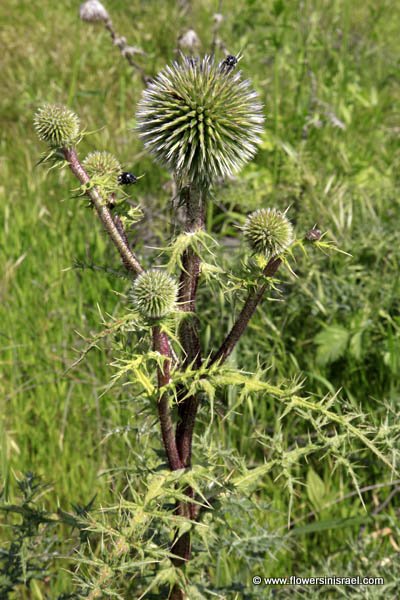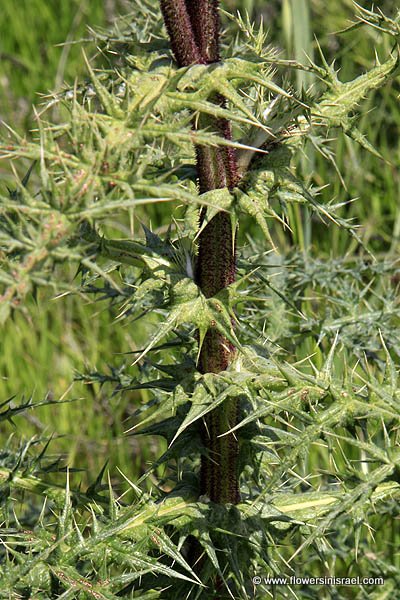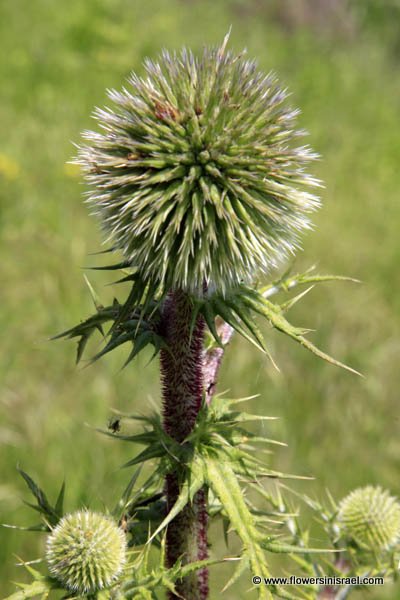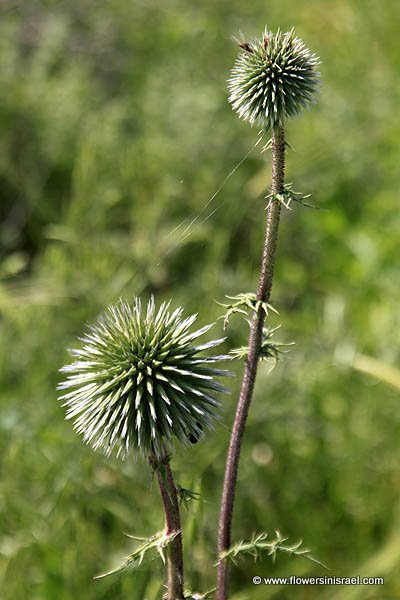Echinops creticus, Viscous globe-thistle, קיפודן סורי, קיפודן דביק
| Scientific name: | Echinops viscosus DC. | |
| Synonym name: | Echinops spinosissimus Turra, Echinops spinosus Sm. In Sibth. & Sm., Echinops creticus Boiss. & Heldr. in Boiss. | |
| Common name: | Viscous globe-thistle | |
| Hebrew name: | קיפודן סורי, קיפודן דביק | |
| Family: | Compositae / Asteraceae, מורכבים |

|
| Life form: | Perennial | |
| Spinescence: | Leaves, bracts | |
| Stems: | Up to 80 cm; stem white or purplish, with or without lanate seta; erect, sturdy, ridged | |
| Leaves: | Alternate, oblong-lanceolate to oblong in outline, 2-3-pinnatisect. | |
| Flowers: | Hermaphrodite; several heads on each stem, up to 10 cm diameter; corolla white, blue, or purple; anthers bluish gray | |
| Fruits / pods: | Achene covered with long straight appressed hairs. Pappus scales distinct to connate, inserted directly on apical plate. | |
| Flowering Period: | June, July | |
| Habitat: | Humid Habitats | |
| Distribution: | Mediterranean Woodlands and Shrublands, Montane vegetation of Mt. Hermon | |
| Chorotype: | Mediterranean | |
| Summer shedding: | Perennating |

Derivation of the botanical name: Echinops, echinos, εχινοϛ, sea-urchin, hedgehog; opsis, like; in allusion to this herb's spiny, globe-shaped flower heads of metallic blue. viscosus, sticky. spinosissimus, spiniest. The Hebrew name: קפודן, קיפודן, kipodan, "a hedgehog", for the flowers are arranged in a spherical inflorescence similar to a hedgehog (kipodan).
Echinops viscosus are common on basaltic soils. Basaltic soils, representing soils which have a heavy texture, a low soil profile and the soil tends to dry out quickly because it is low in organic matter. Basaltic soils are alkaline and the soil layer is usually very shallow. Common in the Hula Valley, Mt. Hermon and the Golan heights. Some suggest the Echinops viscosus as Hoah, חוח = briar, thistle; thorn in the Bible (Job 31:40; Proverbs 26:9; Hosea 9:6), others prefer the Kotz, קוץ = thorn, thistle (Isaiah 32:13; Hosea 10:8). According to Michael Zohary, Echinops viscosus is recommended to be a Barkan, ברקן = briar, thorn. In the Mishnah, Talmud, Midrash, and Targum the Echinops viscosus (היזמא), is mentioned as indigenous to Palestine and Babylon. Bible resources:


|